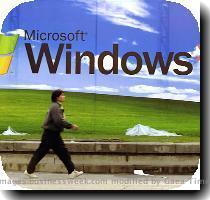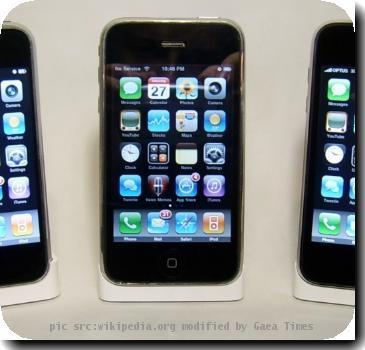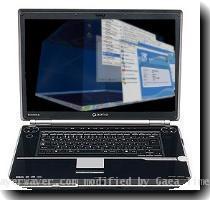Writing on the wall points to Apple tablet, but Steve Jobs still must prove it’s worth buying
By Jessica Mintz, APMonday, January 11, 2010
Apple may wipe slate clean for new tablet computer
SEATTLE — Apple has a knack for spotting problems we didn’t know we had. It can leave us wondering how we survived without vast libraries of music and TV shows in our pockets or the comfort of knowing “there’s an app for that.”
Now, speculation is growing that in two weeks Apple will unveil a tablet-style touch-screen computer that is bigger than an iPhone but smaller than a standard laptop. If indeed that is Apple’s next move — the company won’t comment — it would have to show us why we ought to pay for yet another Internet-connected screen, on top of the TVs, computers and smart phones we already have.
Tablets, also called slates, are one-piece computers with big screens and no keyboards, though some models can convert from a regular laptop to a tablet by flipping the screen around to hide a keyboard.
Such devices have been around since the early 1990s, including one from Toshiba Corp. that weighed 3.3 pounds and cost about $3,500. But tablets haven’t seen much success in the mainstream. At the peak in 2007, manufacturers shipped about 1.5 million tablets worldwide — less than 1 percent of the personal computers shipped that year, according to the research firm IDC. Only about one-third of those tablets were for consumers. The rest were used in specialized settings such as doctor’s offices or warehouses.
Bill Gates, co-founder of Apple nemesis Microsoft Corp., predicted repeatedly during the 2000s that tablets were about to take off. He was wrong because those tablets required people to use a pen-shaped stylus to tap buttons or write on the screen, which was attractive in workplaces where employees needed to check boxes or fill out forms. For most people, though, using a stylus for regular computer tasks such as editing a spreadsheet was more cumbersome than using a mouse and keyboard.
No one has given up on tablet computers running Windows; several cropped up last week at the International Consumer Electronics Show in Las Vegas, including prototypes from Hewlett-Packard Co. and Dell Inc.
But it seems it will be Apple CEO Steve Jobs who swoops in with a tablet that takes advantage of recent technology improvements and garners the most buzz.
Dell and HP didn’t present a retail-ready tablet because the companies want to be able to adjust if Apple’s vision turns out to be radically different, says computer industry analyst Roger Kay of Endpoint Technologies Associates.
“If Apple blows it out of the park, we know that that’s what the space is going to look like for a while,” he says.
While older tablets weren’t pitched as Internet-surfing devices, modern ones will be able to take advantage of near-ubiquitous wireless Internet access, as well as our growing willingness to pay for monthly data plans for smart phones and little netbooks.
Touch screens and the underlying software are also dramatically better today, and we’ve gotten used to pinching, swiping and using on-screen keyboards thanks to the popularity of Apple’s iPhone.
And gadgets — especially ones made by Apple — are thinner and sleeker all the time, making them more portable than clunky early tablets.
We’ve seen this happen before: Portable music players and “smart” phones had existed before the iPod and the iPhone came along, and yet it was Apple that redefined those categories.
Still, an Apple tablet could have a harder time becoming a mainstream success than those gadgets, if only because there is not necessarily a compelling reason for one.
In the absence of confirmation from Apple, analysts have many guesses about how Jobs would position an Apple tablet. Some think it will simply be an oversized iPod Touch, a music player that is also used to view movies, family photos and other content on the go. Others believe Apple is building the tablet with an eye to the burgeoning electronic book market (even though Jobs said in 2008 that “people don’t read anymore.”) Still others position it as a companion screen to use while watching television — the tablet would deliver information related to the program airing on the TV.
But the mechanics of the human body may be stronger than Jobs’ charisma. We tolerate devices like smart phones with their tiny screens and awkward keyboards because they’re fine for what we need them for — quick, on-the-go reading and messaging. As soon as the screen gets bigger, though, people tend to start wanting to do more with the device, such as typing longer missives, says Mark Rolston, chief creative officer for Frog Design, a firm that designed one of Apple’s first computers. At that point, the limitations of small screens and the lack of a real keyboard could be intolerable, and people would move up a rung to a small laptop.
Jon Gibs, vice president for media insight at The Nielsen Co., says he can’t think of a situation in which a tablet screen would be the best one available for watching video. At home, the TV is the more natural choice, while on the go, a pocket-sized iPhone would be more convenient.
Rolston believes Apple won’t market a tablet as a replacement for a workhorse laptop. Instead, Jobs will describe a limited set of uses for the device at first, Rolston says, and later Apple may broaden how it advertises the tablet. He pointed to the way the iPhone evolved from easy-to-use phone to multipurpose pocket computer a year after its debut with the advent of the App Store, which sells add-on software of all sorts.
Perhaps some of the biggest hopes for tablets are bubbling in media companies that have failed to capture enough advertising on the Internet and now crave a new way to sell interactive content. Something like Apple’s iTunes program, which lets people buy songs, TV shows and movies to put on their iPods and iPhones, could be used to distribute newspaper and magazine stories or TV programming on a tablet.
Already publishers are flocking to e-book readers such as Amazon.com Inc.’s Kindle, but photo and graphics-rich magazines and video or multimedia installments from newspapers don’t look very good on the e-readers’ black, white and gray “e-ink” screens.
A tablet with a color screen, however, could create new opportunities. Sports Illustrated published a video online of a tablet-based digital magazine that lets readers glide through content, jump from a single photo to an entire gallery, view features and ads with embedded video segments, and play games on the tablet that tie into sporting events on TV.
Wired magazine is working on a made-for-tablet edition. While the business model isn’t final, Wired will likely charge a subscription fee for some or all of the tablet version, says editor-in-chief Chris Anderson.
Smart phone screens are too small for long-form reading and high design, while PC screens require people to lean in across the keyboard to read. A tablet would have both the intimacy and the screen real estate to approximate a magazine experience, Anderson says.
“We decided this was the big one,” Anderson says.
Apple’s stock more than doubled in the last year, partly because of investors’ expectations that the company has another blockbuster coming. But tablets would still have to get into consumers’ hands, which makes the price perhaps the most important question.
If a tablet doesn’t replace a laptop or any other gadget, it would have to be inexpensive enough to feel like an accessory, not an investment. And yet it might also have to come with a speedy cellular data plan to ensure people can access content everywhere. That could mean paying at least another $30 a month on top of what people shell out for cell phone, TV and broadband service.
Kay thinks many people would still likely be interested.
“For this jewel-encrusted status symbol,” he says, “the answer is absolutely yes.”
Tags: 2010 Consumer Electronics Show, Apple Tablet, Arts And Entertainment, Communication Technology, Consumer Electronics, Consumer Electronics Show, Events, iTunes, Magazines And Journals, Mobile Communications, Mobile Media, North America, Online Media, Seattle, Sports, Television Programs, United States, Washington


